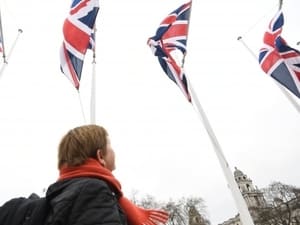StChill.com
Questions about The UK Today - Life in the UK Q&A
Life in the UK - The UK Today - Practice Test Questions - Chapter 4 Section 1
Question 1: Where is the UK geographically located?
Question 2: What percentage of the total British population is located in Northern Ireland?
Question 3: What percentage of the total British population is located in Scotland?
Question 4: What percentage of the total British population is located in Wales?
Question 5: What percentage of the total British population is located in England alone?
Scroll down for the answers.
Question 6: The population is very equally distributed over the four parts of the UK. True or false?
Question 7: The UK population is ethnically diverse and changing rapidly, especially in large cities such as London. True or false?
Question 8: What was the population of the UK in 1600?
Question 9: What was the population of the UK in 1700?
Question 10: What was the population of the UK in 1801?
Scroll down for the answers.
Question 11: What was the population of the UK in 1851?
Question 12: What was the population of the UK in 1901?
Question 13: What was the population of the UK in 1951?
Question 14: What was the population of the UK in 1998?
Question 15: What was the population of the UK in 2005?
Scroll down for the answers.

Question 16: What was the population of the UK in 2010?
Question 17: What is the distance between the north coast of Scotland and the south-west corner of England?
Question 18: The longest distance on the mainland in the UK is from John O’Groats on the north coast of Scotland to a location in the south-west corner of England known as:
Question 19: In the UK, most people live in towns and cities and very small parts of Britain are countryside. True of false?
Question 20: In the UK, many people continue to visit the countryside for holidays and for leisure activities such as walking, camping and fishing, true or false?
Scroll down for the answers.
Question 21: What is the currency in the UK?
Question 22: How many pence are there in a pound?
Question 23: Which TWO British areas have their own banknotes?
Question 24: Northern Ireland and Wales have their own banknotes, which are valid everywhere in the UK. However, shop and businesses do not have to accept them. True or false?
Question 25: What is the note with the highest value in the UK?
Scroll down for the answers.
Question 26: What is the coin with the highest value in the UK?
Question 27: Which of the following is NOT a city of the UK? Belfast, Newport, Dublin, Dundee.
Question 28: What is the capital city of Scotland?
Question 29: What is the capital city of Wales?
Question 30: What is the capital city of the UK?
Scroll down for the answers.
Question 31: Where is the city of Swansea located?
Question 32: Which is the capital city of Northern Ireland?
Question 33: Where is the city of Bradford located?
Question 34: What percentage of the British population has a parent or grandparent born outside of the UK as a result of post-war immigration?
Question 35: The English language has many accents and dialects. True or false?
Scroll down for the answers.
Question 36: In Wales, many people speak Gaelic – a completely different language from English – and it is taught in schools and universities. True or False?
Question 37: In Wales, Gaelic is spoken in some parts of the coast. True or False?
Question 38: In Scotland, Gaelic is spoken everywhere. True or False?
Question 39: In Scotland, Gaelic is spoken in some parts of the Highlands and Islands. True or False?
Question 40: In Wales, Gaelic is the main language. True or False?
Scroll down for the answers.
Question 1: Where is the UK geographically located?
Answer: In the north west of Europe.
Question 2: What percentage of the total British population is located in Northern Ireland?
Answer: Less than 3%.
Question 3: What percentage of the total British population is located in Scotland?
Answer: Over 8%.
Question 4: What percentage of the total British population is located in Wales?
Answer: 5%.
Question 5: What percentage of the total British population is located in England alone?
Answer: 84%. The population is very unequally distributed over the four parts of the UK. England more or less consistently makes up 84% of the total population, Wales around 5%, Scotland just over 8%, and Northern Ireland less than 3%.
Question 6: The population is very equally distributed over the four parts of the UK. True or false?
Answer: False. The population is very unequally distributed over the four parts of the UK. England more or less consistently makes up 84% of the total population, Wales around 5%, Scotland just over 8%, and Northern Ireland less than 3%.
Question 7: The UK population is ethnically diverse and changing rapidly, especially in large cities such as London. True or false?
Answer: True.
Question 8: What was the population of the UK in 1600?
Answer: Just over 4 million people. The population of the UK in 1600 was just over 4 million people.
Question 9: What was the population of the UK in 1700?
Answer: 5 million. The population of the UK in 1700 was 5 million people.
Question 10: What was the population of the UK in 1801?
Answer: 8 million.
Question 11: What was the population of the UK in 1851?
Answer: 20 million people. The population of the UK in 1851 was 20 million people.
Question 12: What was the population of the UK in 1901?
Answer: 40 million. The population of the UK in 1901 was 40 million people.
Question 13: What was the population of the UK in 1951?
Answer: 50 million. The population of the UK in 1951 was 50 million people.
Question 14: What was the population of the UK in 1998?
Answer: 57 million.
Question 15: What was the population of the UK in 2005?
Answer: Just under 60 million.
Question 16: What was the population of the UK in 2010?
Answer: Just over 62 million people. The population of the UK in 2010 was just over 62 million people.
Question 17: What is the distance between the north coast of Scotland and the south-west corner of England?
Answer: 870 miles. In the UK, the longest distance on the mainland is from John O’Groats on the north coast of Scotland to Land’s End in the south-west corner of England. It is about 870 miles (approximately 1,400 kilometres).
Question 18: The longest distance on the mainland in the UK is from John O’Groats on the north coast of Scotland to a location in the south-west corner of England known as:
Answer: Land’s End. The longest distance on the mainland is from John O’Groats on the north coast of Scotland to Land’s End in the south-west corner of England. It is about 870 miles (approximately 1,400 kilometres).
Question 19: In the UK, most people live in towns and cities and very small parts of Britain are countryside. True of false?
Answer: False. Most people live in towns and cities but much of Britain is still countryside.
Question 20: In the UK, many people continue to visit the countryside for holidays and for leisure activities such as walking, camping and fishing, true or false?
Answer: True. Many people continue to visit the countryside for holidays and for leisure activities such as walking, camping and fishing.
Question 21: What is the currency in the UK?
Answer: Pound. The currency in the UK is the pound sterling (symbol £).
Question 22: How many pence are there in a pound?
Answer: 100 pence. There are 100 pence in a pound.
Question 23: Which TWO British areas have their own banknotes?
Answer: Northern Ireland and Scotland.
Question 24: Northern Ireland and Wales have their own banknotes, which are valid everywhere in the UK. However, shop and businesses do not have to accept them. True or false?
Answer: False. Northern Ireland and Scotland have their own banknotes, which are valid everywhere in the UK. However, shops and businesses do not have to accept them.
Question 25: What is the note with the highest value in the UK?
Answer: £50. The note with the highest value in the UK is the £50 note.
Question 26: What is the coin with the highest value in the UK?
Answer: £2.
Question 27: Which of the following is NOT a city of the UK? Belfast, Newport, Dublin, Dundee.
Answer: Dublin.
Question 28: What is the capital city of Scotland?
Answer: Edinburgh. The capital city of Scotland is Edinburgh.
Question 29: What is the capital city of Wales?
Answer: Cardiff. The capital city of Wales is Cardiff.
Question 30: What is the capital city of the UK?
Answer: London. The capital city of the UK is London.
Question 31: Where is the city of Swansea located?
Answer: In Wales. Swansea is located in Wales.
Question 32: Which is the capital city of Northern Ireland?
Answer: Belfast. The capital city of Northern Ireland is Belfast.
Question 33: Where is the city of Bradford located?
Answer: In England. Bradford is located in England.
Question 34: What percentage of the British population has a parent or grandparent born outside of the UK as a result of post-war immigration?
Answer: Nearly 10% of the population. Post-war immigration means that nearly 10% of the population has a parent or grandparent born outside the UK.
Question 35: The English language has many accents and dialects. True or false?
Answer: True.
Question 36: In Wales, many people speak Gaelic – a completely different language from English – and it is taught in schools and universities. True or False?
Answer: False. In Wales, many people speak Welsh – a completely different language from English – and it is taught in schools and universities.
Question 37: In Wales, Gaelic is spoken in some parts of the coast. True or False?
Answer: False.
Question 38: In Scotland, Gaelic is spoken everywhere. True or False?
Answer: False.
Question 39: In Scotland, Gaelic is spoken in some parts of the Highlands and Islands. True or False?
Answer: True.
Question 40: In Wales, Gaelic is the main language. True or False?
Answer: False.
StChill.com
Contact us













